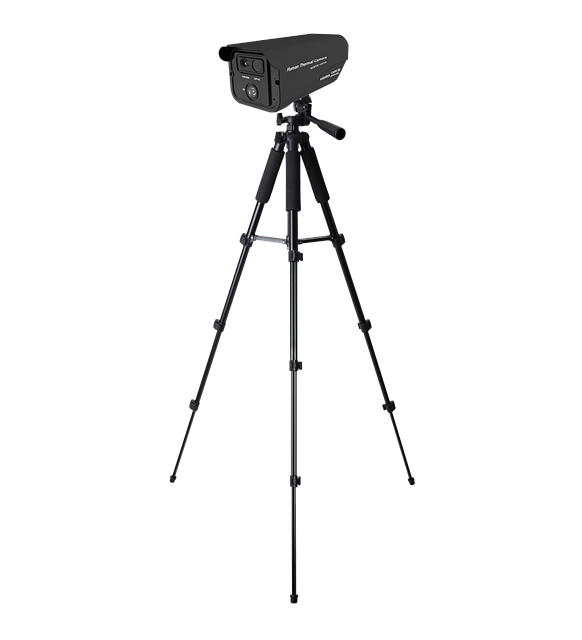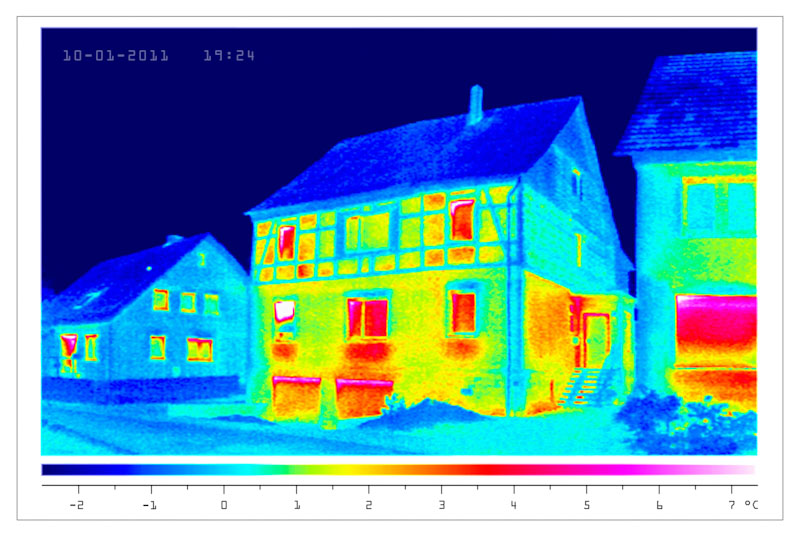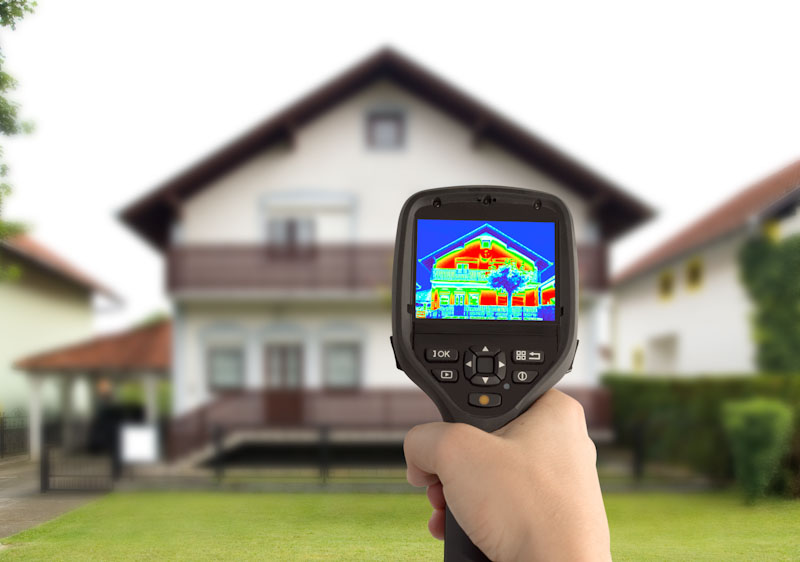Are you considering getting a home inspection or are you a home inspector yourself? You probably know about the inspections that can cover the exterior walls and structure. But do you know all about thermal imaging home inspections?
These specialized inspections use cutting-edge technology to provide a more comprehensive assessment of your property.
In this article, we will explore the benefits of thermal imaging home inspections.
How Does It Work?
Before we dive into the advantages of thermal imaging, let’s take a moment to understand the technology behind it.
The Thermal Imaging Camera

The term thermal imaging camera, infrared camera, and ir camera are all interchangeable.
Thermal imaging cameras are equipped with sensors that can detect infrared radiation. When an object emits heat, it releases this radiation in the infrared spectrum which is invisible to the human eye.
The thermal imaging camera captures this radiation and converts it into a visual representation of radiant temperature, usually in the form of a detailed color-coded image called a thermogram.
Thermography measures surface temperatures, and the resulting thermal images are called thermograms.
What Do All The Colours Mean?

The colours on the image represent different temperatures, with warmer areas appearing as red or yellow and cooler areas appearing as blue or purple.
Why is this important?
This infrared technology allows inspectors to identify areas of concern that cannot be seen with the naked eye. It is particularly useful for detecting moisture, insulation gaps, roof leaks, air-conditioner compressor leaks, some structural defects, and some electrical faults, among other things. This technology can play a crucial role in ensuring the safety and efficiency of various electrical systems, and structures.
The Advantages of Home Inspections
Home inspections play a vital role in identifying potential problems and ensuring the safety and integrity of a property.
When it comes to buying or selling a home, a thorough inspection is essential.
It provides both buyers and sellers with a comprehensive understanding of the property’s condition, allowing for informed decisions and negotiations.
A full home inspection report is not just a formality; it is a valuable tool that can protect property investment and provide peace of mind.
How do regular and infrared home inspections differ from one another?
Regular home inspections are visual examinations.
So whilst conventional home inspections are very valuable, they have limitations when it comes to identifying hidden problems.
This is where thermal imaging proves invaluable. Let’s explore the advantages it offers.
Detecting Hidden Problems

One of the significant advantages of a thermal imaging camera is its ability to detect hidden problems that are not visible to the naked eye. By capturing heat signatures, it can reveal issues such as water damage (because water and moisture absorb heat energy), broken seals in double-paned windows and insulation gaps.
By pinpointing areas of insufficient insulation, damaged or wet insulation, remedial work can be commissioned that leads to lower energy usage and lower utility bills.
An infrared camera can also identify hidden water leaks behind walls or plumbing leaks underneath flooring. Most leaks go otherwise would go unnoticed until serious damage occurs.
In addition, thermal imaging can identify electrical hot spots such as overloaded circuits or faulty wiring, which can pose serious fire hazards. By taking immediate action based on these findings, you can ensure the safety of your home and minimize the risk of serious electrical fires and accidents.
Moreover, it can detect potential pest infestations, such as rats, mice, and other larger pests.By identifying potential issues through thermal imaging, issued can be identified and addressed before they escalate into more significant problems.
The home inspector could even identify risky flue leaks, which can result in carbon monoxide poisoning.
Heating Ventilation And Air Conditioning (HVAC)
Thermal imaging can help you optimize the efficiency of your HVAC system. By identifying areas of heat loss or inadequate cooling, you can make necessary adjustments to ensure optimal performance and energy savings.
Thermal Bridging
Furthermore, thermal imaging can assist in identifying thermal bridging, which occurs when there is a pathway for heat to escape through the building envelope. By addressing thermal bridges, you can improve the overall insulation of your home and reduce energy consumption.
Overall, thermal imaging provides valuable insights into the hidden aspects of your home’s condition, allowing you to make informed decisions and take proactive measures to maintain its integrity, safety, and energy efficiency.
Case Study 1: Uncovering Hidden Water Damage
A homeowner noticed a damp smell in their basement but could not identify the source of the issue. A thermal imaging inspection revealed a hidden water leak behind a wall, allowing for prompt repairs and preventing further damage.
Upon further investigation, it was discovered that the water leak was originating from a cracked pipe that had been concealed within the wall. The thermal imaging camera, with its ability to both detect moisture and temperature differences, clearly showed the presence of moisture and the extent of the damage caused by the leak.
By identifying the potential dangers of hidden water damage early on, the homeowner was able to take immediate action and prevent mould growth and mildew, which could have posed health risks to the occupants of the house.
Case Study 2: Reduce Energy Loss
In this case study, a homeowner was struggling with high heating bills. Through a thermal imaging inspection, it was discovered that certain areas of their attic were not adequately insulated. By addressing the insulation gaps, the homeowner was able to reduce thermal energy and loss and lower their utility expenses.
Upon conducting the inspection, it became evident that the insulation in darker areas of the attic were unevenly distributed, resulting in significant heat loss. The thermal camera clearly displayed the temperature differences between well-insulated areas and those with missing insulation or gaps.
By identifying and addressing the insulation gaps, the homeowner was able to improve the energy efficiency of their home. T
his not only reduced their heating bills but also enhanced the overall comfort of their living space.
The thermal imaging inspection allowed the homeowner to make informed decisions about where to focus their insulation efforts, enhancing energy conservation and reducing their carbon footprint.
The Thermal imaging Inspection is a Quick and Easy Service

Results from thermal imaging inspections can be obtained in less than a day. The buyers and sellers don’t even have to show up at the spot because the thermal inspection itself is non-invasive. For a busy buyer or seller who needs to get precise pictures without disrupting their life, thermal imaging inspections are a great option.
Thermal Imaging Limitations
A thermal imaging camera is unable to see underlying surfaces or obstacles.
Additionally, environmental factors like wind, rain, and solar radiation can affect thermal imaging.
Before evaluating any thermal image or thermal images themselves, inspectors must be aware of these limitations.
It’s Not A Replacement for Visual Inspection!
You can use thermal imaging camera to identify issues that are invisible to the naked eye. However, a visual home inspection cannot be replaced by thermal imaging.
Thermal scanning and visual home inspection report are mutually supporting services.
Choosing a Thermal Imaging Home Inspection Service
Now that you understand the benefits of thermal imaging, it’s essential to choose a reliable and experienced service provider for your home inspection needs.
It’s crucial that the home inspectors are properly trained in the use of thermal imaging technology to provide accurate and reliable results.
Additionally, consider their reputation, customer reviews, and the comprehensiveness of their inspection reports.
Ask Questions!
Don’t hesitate to ask questions. Here are some examples:
-
What certification and training standards have they met? Check that these meet local regulations and standards.
-
Are they experienced in the local building styles? This will help them interpret results.
-
What building areas will they assess? So that you understand the scope of their service.
-
Do they supply regular digital photos alongside the thermal images in order to make the report more user-friendly? This will provide an accurate point of reference for improvements and repairs.
Understanding their process will help you feel confident in the quality of the home inspection services.
Is a Thermal Imaging Inspection Worth the Expense?

For Home Buyers and Home Owners
A thermal imaging home inspection offers numerous benefits that go beyond the scope of traditional inspections. The ability to detect hidden problems, prevent future damage, and enhance energy conservation makes a thermal imaging home inspection an invaluable service.
So, when it’s time for a home inspection, consider the advantages of thermal imaging technology and choose a service provider that can provide you with comprehensive insights about your property.
A thorough home inspection, including thermal imaging home inspection, is an investment in your property’s long-term well-being and your peace of mind.
Remember that where the initial inspection identified an action plan, a follow-up inspection can be beneficial to see the outcome of remedial works.
For A Home Inspection Company
Yes there are costs involved in purchasing and maintaining thermal cameras, and in obtaining the necessary training and certification in thermographic inspections.
However, offering a thermal imaging home inspection gives you the ability to provide a great additional service that is entirely complementary to your existing visual home inspection services.
Since the home inspector is generally already at the property, and there is no additional fuel consumption, it makes perfect economic and ecological sense to offer an infrared scan.
Find out about The different types of home buyers survey in the UK
Explore our Tips on how to save energy in the home
Check out What to look for when doing a home inspection
Read Tips on how to save energy in business!
See more Helpful Content
Visit our Homepage
